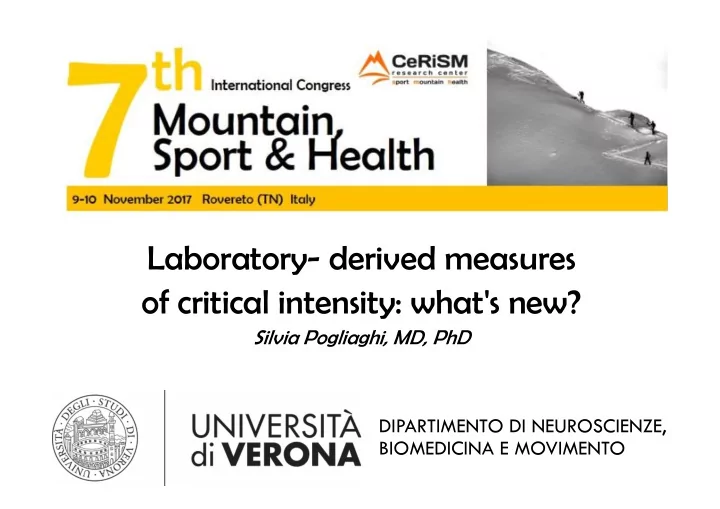

Laboratory- derived measures of critical intensity: what's new? Silvia Pogliaghi, MD, PhD DIPARTIMENTO DI NEUROSCIENZE, BIOMEDICINA E MOVIMENTO
Exercise-intensity domains: Exercise duration, VO2 profile, change in intracellular composition Steady-state non tenable Inefficiency, intolerance Increasing Metabolic instability Heavy-Severe boundary Delayed homeostasis Valid identification is essential for individualised quantification of exercise «dose» Jones AM and Poole DC, 2005
Why measure heavy- severe boundary? � S UBMAXIMAL INDEX OF AEROBIC FITNESS � SENSITIVE TO AEROBIC TRAINING � I NDICATOR OF “ INTERNAL LOAD ” � T ARGET INTENSITY FOR EXERCISE TRAINING � D ETERMINANT OF SPORT PERFORMANCE
How to measure?
How to measure? VT 2 VAM D max CP MLSS RCP IAT OBLA VT LT 2 HR DP AT
Alternatives? What’s new? � COST (time, equipment, expertiese) � EFFORT (children, patients, motivation) � RISK ( older adults , patients) � Objectivity (RCP) � Correspondance between measures
Age Weight Stature VO 2max # BMI (mL·kg -1 ·min -1 ) (yrs) (kg) (m) Mean ± SD 48 ± 17 76 ± 8 1.75 ± 0.09 25 ± 3 39.4 ± 11.4 32 Range 23-74 62-98 1.56-1.90 20-31 21.8-59.8 Can we determine critical intensity from deoxyHb profile? Correspondence with gold standard Bellotti C, MSSE 2013
MLSS deoxyHb BP VO 2 2.25 ± 0.54 2.23 ± 0.59 (L·min -1 ) Bellotti C, MSSE 2013
deoxyHb BP and RCP Murias JM, RPNB 2013 N=20 N=118 Fontana FY, JSMC 2015
Can maximal effort be spared? � EFFORT � RISK � COST
16 13,5 Km/h, 6 min 14 12 V OBLA (Km/h) 10 8 y = (-0.575 * x) + 15.73 r 2 = 0.86 6 0 2 4 6 8 10 12 [LA] (mmol/l) Sirtori M.D. e coll. Med.Sport 46: 281-286, 1993
14 ♂ 31 ± 7 yrs (range 23-44) 49 ± 7 ml*Kg -1 *min -1 (range 44-65) Fontana FY, JSS 2016
Vs validated intensity Fontana FY, JSS 2016
SUBJECTS: 40 healthy ♂ : 42±18 years (range 22-78) , 48±8 ml Kg -1 min -1 (range 25-68)
350 200 A B r = 0.89 p < 0.001 Bias = 1.5 difference between measures (watt) b 0 = 17.97; b 1 = 0.91 Precision = 20.3 300 z = 0.95; p= 0.33 SEE = 19.9 W validated critical power (watt) 100 250 200 0 150 r = 0.91 p < 0.001 -100 Bias = 0.02 b 0 = 0.13; b 1 = 0.99 100 Precision = 18.3 SEE = 18 W z = 0.01; p= 0.99 50 -200 50 100 150 200 250 300 350 50 100 150 200 250 300 350 estimated critical power (watt) average between measures (watt) 200 D 200 C b1 = 0.27 ; b0 = -9.06 b1 = 0.13 ; b0 = -7.63 p = 0.02 p = 0.41 difference between measures (watt) difference between measures (watt) 100 100 0 0 -100 -100 b1 = 0.00 ; b0 = 0.01 b1 = 0.01 ; b0 = -0.37 p = 0.99 p = 0.94 -200 -200 40 50 60 70 80 90 100 20 30 40 50 60 70 80 % peak power output age (yeras)
Correspondance between measures? VT 2 HHb DP VAM D max CP MLSS 3-min SM test RCP VT IAT OBLA LT 2 HR DP AT
Same thing from different angles? HHb DP VT 2 VAM D max CP MLSS RCP IAT OBLA VT LT 2 HR DP AT
� � O 2 - exercise intensity in Incremental vs Constant PO exercise The issue of “Translation” moderate heavy severe extreme V � O 2max severe Critical Intensity � O 2 (L·min -1 or %) heavy LT V moderate Constant-intensity Ramp-incremental MRT GET/VT 1 CP/MLSS P upper Intensity (PO, speed) Keir et al. (in review)
Incremental exercise → Constant PO 4.5 3.1 L·min -1 = 250 W 4.0 3.1 L·min -1 = 270 W 3.5 � O 2p (L·min -1 ) 3.0 -1 ) 2.5 VO 2p (L ⋅ min 2.0 � 1.5 1.0 0.5 MRT 0.0 0 25 50 75 100 125 150 175 200 225 250 275 300 325 350 375 400 WR (watts) Power Output (watts) corrected W= (VO 2 -intercept) – ∆ W * MRT ∆ time slope
Incremental exercise → Constant PO 4.5 4.0 Slow Component 3.5 VO 2p (L·min -1 ) 3.0 -1 ) 2.5 VO 2p (L ⋅ min 2.0 1.5 1.0 0.5 0.0 0 25 50 75 100 125 150 175 200 225 250 275 300 325 350 375 400 WR (watts) Power Output (watts) corrected W= - (VO 2 -VO 2 @GET) * (slope 2 -slope 1 ) (slope 2 * slope 1 )
CP, RCP, MLSS and HHB BP occur at equivalent VO2? N=12 Keir DA, MSSE, 2015
Keir DA, MSSE, 2015
How to measure heavy- severe boundary � W E HAVE « SMART » ALTERNATIVES � I NTERCHANGEABLE « WITH CARE » TO DETERMINE AND MONITOR THE LIMITS OF TOLERABLE ENDURANCE EXERCISE AND ALLOW INDIVIDUALISED TRAINING LOAD QUANTIFICATION
Individual Measure of heavy-severe boundary «Translate» it correctly = Essential for exercise quantification and development of evidence-based, individualised exercise prescription to improve exercise tolerance AND THAT’S ALL I HAVE TO SAY ABOUT THAT
Carlo Capelli Enrico Tam Luca Dal Sacco Paolo Bruseghini Federico Fontana Giorgia Spigolon Alessandro Colosio Don Paterson Juan Murias Daniel Keir
GRAZIE THANK YOU MERCI GRACIAS
Recommend
More recommend